One of the most popular, most successful, and best-looking games for Microsoft's Xbox is now on the PS2, and in certain ways it's better than the original. Reminiscent less of games like Metal Gear Solid and more of games like Thief: The Dark Project and Hitman 2: Silent Assassin, Tom Clancy's Splinter Cell is a stealth-driven action adventure that sends you, as operative Sam Fisher, around the globe on numerous highly secretive and very dangerous assignments. It all goes down like something straight out of a Hollywood action thriller, complete with plenty of big-budget production values. The game isn't above reproach: Just like its Xbox counterpart, Splinter Cell for the PS2 is a relatively short single-player-only game consisting of heavily scripted missions that can sometimes turn into trial-and-error exercises that undermine the game's otherwise pervasive sense of suspense. The graphics have also lost some of their luster in translation, though some worthwhile new features and gameplay tweaks make Splinter Cell for the PS2 more than just a watered-down Xbox port. And at its core, it's a great action game, one that's already met with tremendous acclaim.
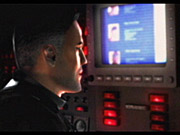
Additionally, this version of Splinter Cell replaces the Xbox version's unimpressive in-engine cutscenes with better-looking prerendered cutscenes, and the completely redone intro does a better job of setting the stage. And while the new cutscenes aren't frequent, they do help tie together Splinter Cell's otherwise disparate scenarios. It's also worth noting that those who've already played Splinter Cell on the Xbox or PC will find that the story and the levels in Splinter Cell for the PS2 take a few short detours. There are enough little changes that hard-core Splinter Cell fans would do well to give the PS2 version a shot, if only to see the new power plant level, which is spliced into the middle of the game. It's also worth noting that the simultaneously released GameCube version has most of the same qualities as the PS2 version but doesn't get the power plant level, yet it does have slightly sharper graphics, faster loading times, and some clever if gimmicky connectivity features with the Game Boy Advance. At any rate, if all you wanted to know was how the PS2 version of Splinter Cell stacks up to the others, now you're all set.
Or maybe you're still wondering what a splinter cell actually is. The game's title refers to the unusual role of Sam Fisher, a highly trained and experienced soldier working for a top-secret military organization, Third Echelon, that's attempting to rid the world of a high-tech terrorist threat. If Fisher's caught, the US government will disavow its affiliation with his mission. Worse yet, one false move and Fisher may inadvertently instigate World War III. So the pressure's on, but Fisher's as cool as they come. Though he's skilled as a fighter, stealth is his only real option, and the fate of the free world hangs in the balance as he undertakes a number of high-stakes covert operations. The game's plot, which is set in the near future, is straight out of a Clancy thriller and involves Fisher taking on Clancy's favorite tag team: the Russians and the Chinese.
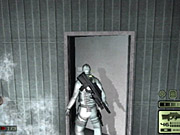
In fact, the variety of moves at Fisher's disposal is probably the highlight of Splinter Cell. Sam has something for every occasion: He can move quite quickly from a crouched position, and if you tread carefully while crouching, you'll be almost invisible and almost silent. He can climb ladders, chain-link fences, and more. He can rappel down walls (and kick through glass windows while doing so), climb hand over hand (or using all four limbs) across horizontal pipes, and zip across downward-slanted ropes or wires. He can put his back against a wall and lean or shoot around corners, he can peek behind doors that are slightly ajar, and he can make soft landings or perform evasive rolls. Fisher can also kick off a wall in midjump, and his coolest move (though it isn't very practical) allows him to stand in the splits atop a narrow passageway and then either shoot unsuspecting opponents or drop down to deliver a stunning blow.
Sneaking up behind an opponent allows Fisher to either knock the foe unconscious with an elbow strike or a pistol whip or grab the enemy and take him hostage. Fisher can then use the opponent as a human shield against other enemies, or in some cases interrogate him or force him to do such things as activate retinal scanners that otherwise prevent passage. He'll eventually have to dispatch his hostage one way or another, and then he can pick up and move the prone body out of the sight of enemy patrols. Fortunately for you, unconscious foes will awaken only if discovered by their allies.
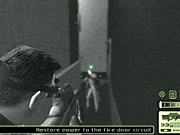
More interestingly, the SC-20K can be used to fire remote camera probes, nauseating smoke bombs, or a distraction camera that can be used to lure guards away from their posts and then give them a mouthful of knockout gas. Such funky devices aren't always strictly necessary for finishing a mission, but they're fun to use and can help you avoid getting into a tight spot. Fisher can also get his hands on frag grenades and wall mines, though explosives aren't really his style. Throwing cans or bottles to distract foes is more up his alley.
Picking locks is definitely his style too, and he can use his trusty lock picks to bypass any locked doors. The game presents a great simulation of lock-picking in which you rotate the left analog stick until you find the pin (you'll feel the controller vibrate), wiggle the stick until Fisher nudges the pin loose, and then repeat the process as many times as there are pins in the lock. Some of Fisher's other neat gadgets include an optic cable that can be slid under doorways to give you a gander at what's on the other side, a camera jammer that disrupts security cameras, and emergency flares that can draw the fire of automated heat-sensitive gun turrets. Fisher is basically a high-tech government ninja, what with all this stuff and his combination night-vision and heat-vision goggles, which also gain a magnifying scope in this version. The odds are always against him, but he has a big-time element of surprise. His moves and gadgets aren't just for show, either, as Splinter Cell will require you to make use of almost all of Fisher's various abilities in most every mission.
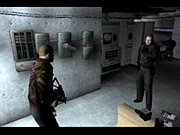
In other missions, the alarm can go off several times before Third Echelon pulls the plug on you, and sometimes there's no alarm to worry about at all. Sometimes the alarm will go off at scripted moments if you've killed or knocked out a guard leading up to that point and failed to completely hide his body. In the Xbox version of Splinter Cell, this could force you into a perpetual mission-failure cycle, though here, not only do you get an onscreen indicator of how many times you're allowed to trip the alarm before the mission's a failure, but if you do fail by tripping too many alarms, you'll restart from the last checkpoint with at least two strikes left. This is part of why the PS2 version of Splinter Cell is generally easier than the Xbox version, which isn't entirely a good thing. Further, some mission sequences have been removed from the game altogether, most notably the break-in into the CIA headquarters--you start the mission already inside. Other parts are slightly changed: For instance, in the Xbox version, Fisher infiltrates an oil tanker at sunset, whereas there's a full moon here.
Despite the fact that the PS2 version of Splinter Cell isn't as difficult as previous versions, new Splinter Cell players will still invariably find themselves often screwing up and restarting different sequences. Trial and error to some extent is part and parcel of most gaming experiences, but in Splinter Cell (and other stealth games), sometimes it can get to be a little too much. Part of the problem, as it is with most every stealth game, is that the missions are heavily scripted and play out exactly the same way each time. The suspense is almost nonexistent by the time you reach your fifth attempt at sneaking through that heavily guarded alley, and any sense of urgency is undermined when you realize that the truck you're desperately trying to catch up to or the assassination you're desperately trying to prevent are events that won't be triggered until you cross certain thresholds. Enemy patrols are also triggered at specific points. You can wait forever for that guard to come around the corner, but you won't see him do it until you step forward those last few inches.
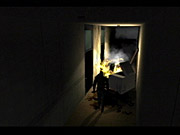
Splinter Cell pushed the envelope in terms of the Xbox's graphical capabilities, so it's no surprise that some compromises had to be made with the PS2 version's visuals. The game runs at a lower resolution, and the environments are generally less detailed. The shadows and lighting effects don't look quite as good, though by PS2 standards, they're very good. The game's frame rate can noticeably start to chug in areas that are particularly heavy on lighting effects, and you'll notice some collision detection and clipping issues, such as when a felled opponent's feet can be seen sticking straight through a door. The game's real-time lighting isn't just for show, since making use of the light and shadows in each area is a critical part of the gameplay. The rest of the game's visuals are also impressive. Fisher's movements are extremely lifelike and highly articulate, and they almost seem as if they were motion captured, even though they weren't. The game's modern environments aren't exactly scenic, but they're still dense with detail.
Splinter Cell also sounds terrific, and as with any self-respecting stealth game, the audio is integral to the experience. You'll actually hear Fisher making a bit more noise the faster he moves, so you'll learn to be your own worst critic as you try to move about silently. All his subtle actions, from lock-picking to drawing his different weapons and gadgets, have a suitably soft sound to go with them, creating the sense that Fisher is extremely skilled at being silent but still runs the danger of making too much noise. Also, Splinter Cell's bass-heavy ambient music is excellent, and it grows louder and faster when you're spotted or caught. But much like in some other stealth-based games, the way the music picks up or quiets down depending on the circumstances has some unintentional side effects that almost feel like cheating: You'll learn to trust the music for knowing whether or not any enemies remain in your vicinity. The coast is clear when the music says so.
Of further note, Splinter Cell has a good amount of speech in it, though disappointingly, the Russians and Chinese speak in English with lame, stereotypical accents rather than speaking in their native tongues. It's implied that Fisher is multilingual, so it would have been great if he'd simply translated for you in the context of the dialogue--especially since you'll really like hearing him speak. He's voiced by Michael Ironside (Starship Troopers and Top Gun), who's absolutely perfect for the role, with his naturally gravelly, gruff manner of speaking. Ironside got a good script to work with for Splinter Cell, and he brings Fisher's character to life with a suitably no-nonsense attitude and plenty of dry humor to round it out.
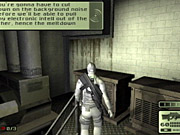
Tom Clancy's Splinter Cell is undoubtedly one of the best examples of a stealth game to date, and it will surely appeal to those who've enjoyed similar games in the past. Or, if you like the idea or even just the look of Splinter Cell but haven't played a stealth game before, then this is a perfectly good place to start. Either way, chances are you'll really enjoy the experience for as long as it lasts. You'll have a great time experimenting with and effectively using Sam Fisher's variety of moves and gadgets, and the game's big missions should provide a significant challenge.